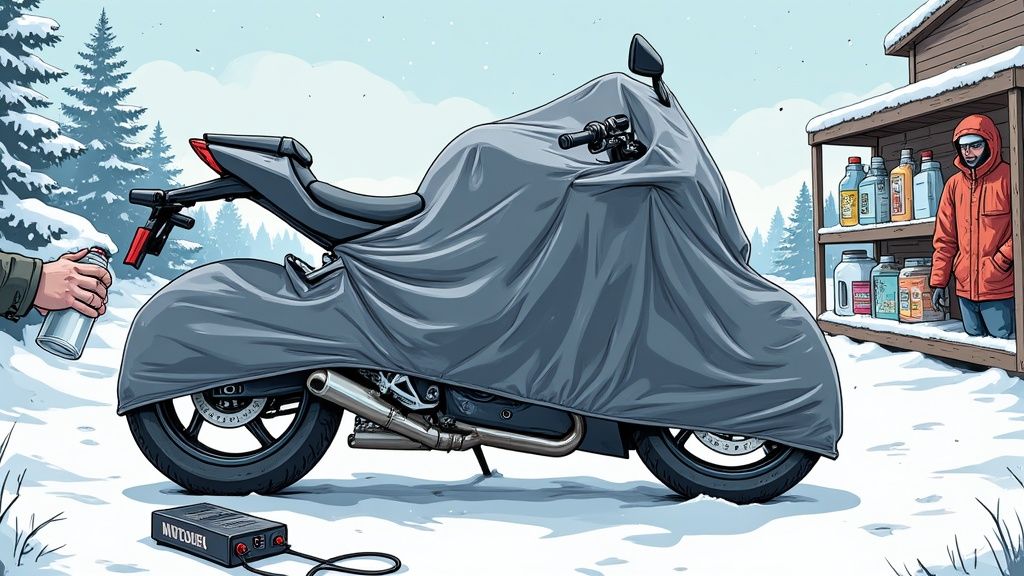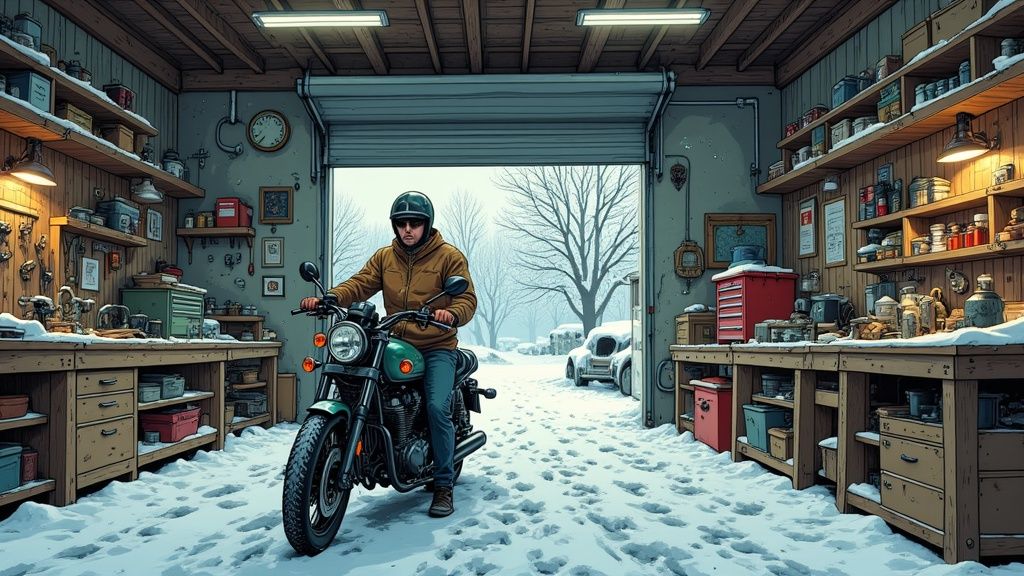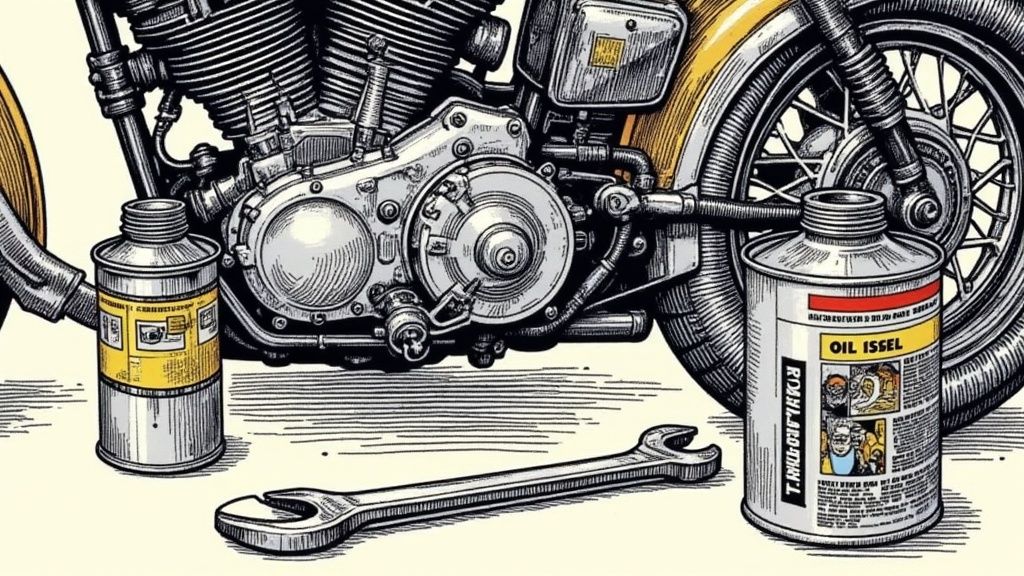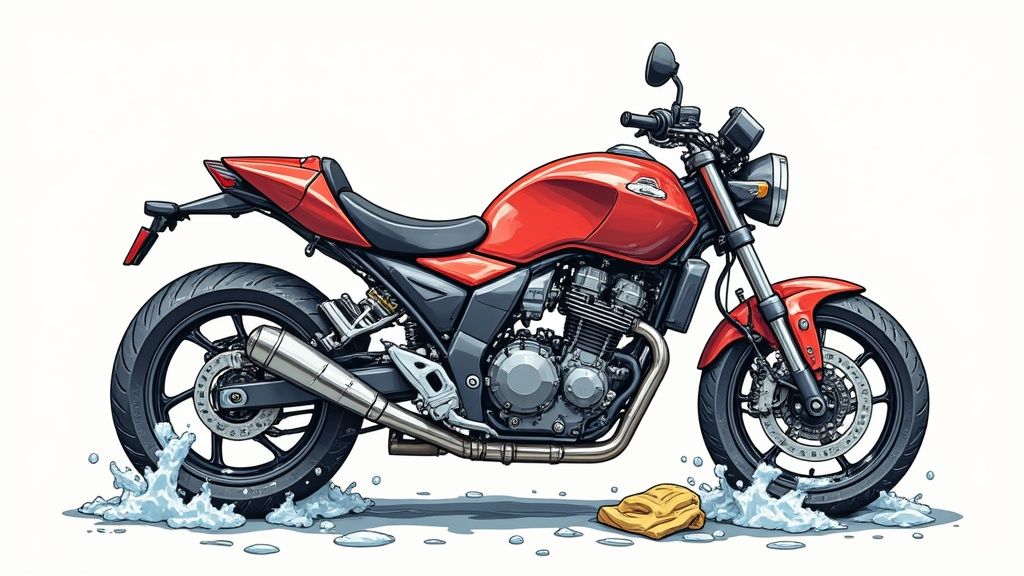
How to Winterize Motorcycle: A Complete Guide for Year-Round Protection
Understanding Why Motorcycle Winterization Matters

Proper motorcycle winterization makes the difference between a bike that starts reliably in spring and one that needs major repairs. Just like any precision machine, motorcycles need protection from harsh winter conditions that can cause rust, corrosion and internal damage. Let’s explore why taking the time to winterize your motorcycle is essential for its longevity.
The Science of Cold-Weather Degradation
Cold temperatures create multiple risks for motorcycle components. Water trapped in fuel lines can freeze and expand, potentially causing cracks and leaks. Engine oil also thickens significantly in cold weather, which means critical engine parts may not get proper lubrication during those first spring starts. As a result, skipping winterization steps often leads to excessive wear and expensive repairs.
The Real Cost of Neglect
Poor winter storage practices frequently result in problems ranging from dead batteries to seized engines. While replacing a battery costs $50-200, rebuilding a damaged engine can run into thousands of dollars. These repair bills far exceed the modest investment needed for proper winterization. Beyond immediate fixes, inadequate winter protection also reduces your motorcycle’s future resale value.
Debunking Winterization Myths
Many riders hold misconceptions about winter motorcycle care. For example, some believe occasionally starting the engine is enough. However, brief starts can actually harm the battery since short runs don’t allow full recharging. Another common mistake is using any available motorcycle cover. Non-breathable covers trap moisture against the bike, encouraging rust formation. That’s why using a quality breathable cover is crucial for allowing airflow while blocking debris. For reliable tracking of your winterization process, Auto Service Logger helps document each maintenance task, including dates and products used.
Mastering Fuel System Preparation for Winter Storage

A properly winterized fuel system is essential for keeping your motorcycle running smoothly when spring arrives. Without the right preparation, you may face serious performance issues and expensive repairs after winter storage. Understanding how to protect your bike’s fuel system during the cold months will help ensure it’s ready to ride when warmer weather returns.
Addressing the Ethanol Issue
Modern gasoline contains ethanol, which creates two main problems during storage. First, it draws in moisture that can corrode metal components throughout the fuel system. Second, as ethanol breaks down over time, it leaves behind sticky deposits that block fuel passages. Fortunately, you can prevent these issues with proper winterization steps.
Winterizing a Carbureted Motorcycle
For bikes with carburetors, start by adding a fuel stabilizer to prevent gas from degrading during storage. Run the engine for several minutes to circulate the treated fuel through the system. Then completely drain both the fuel tank and carburetor to remove any remaining gas that could cause problems. For more detailed guidance, check out this motorcycle winterization guide.
Winterizing a Fuel-Injected Motorcycle
Fuel injection systems need slightly different care. While draining isn’t required, adding a fuel stabilizer remains crucial. Fill the gas tank completely to minimize air space where condensation could form. After adding stabilizer, run the engine so the treated fuel moves through the entire system.
Additional Fuel System Protection
Consider these extra protective measures regardless of your fuel system type. Install a new fuel filter before storage to catch contaminants. Check all fuel lines and connections for damage, replacing any worn parts now instead of discovering problems in spring.
Adapting to Your Climate and Motorcycle
Your location’s winter conditions should guide your storage approach. In areas with sustained freezing temperatures, draining the fuel system completely offers the best protection. Check your owner’s manual for model-specific requirements. To track maintenance procedures for your bike, consider using Auto Service Logger to keep detailed records.
Protecting Your Electrical System Through Winter

Winter storage requires careful attention to your motorcycle’s electrical system. Without proper precautions, cold weather can lead to dead batteries, corroded connections, and frustrating startup problems when spring arrives. Let’s look at how to keep your motorcycle’s electrical components safe during the off-season.
Battery Care: More Than Just a Trickle Charger
Simply connecting a trickle charger isn’t enough to protect your battery through winter. While trickle chargers maintain charge, they can actually damage batteries through overcharging during long storage periods. For better results, use a battery tender that monitors charge levels and only delivers power when needed. This smart charging prevents battery damage and extends its life.
The safest approach is removing the battery entirely and keeping it on a tender in a temperature-controlled space. Contrary to common advice, starting the bike periodically without riding it can harm the battery since idling doesn’t provide enough charge. Learn more about proper battery storage here.
Safeguarding Against Corrosion
Winter moisture poses a major threat to electrical connections. When water gets into connectors, it causes rust and poor conductivity. To prevent this, apply dielectric grease to all electrical contact points before storage. This specialized grease creates a moisture barrier that protects connections throughout the season. For example, coating spark plug boots and battery terminals with dielectric grease helps prevent corrosion damage.
Protecting Sensitive Electronics
Modern motorcycles contain sophisticated electronic systems that need protection from temperature swings and moisture. Place moisture absorbents in your storage area to reduce humidity levels. Store your bike in a climate-controlled space when possible to shield sensitive components from extreme temperatures. You can track storage conditions and maintenance using Auto Service Logger to ensure consistent protection.
A Proactive Maintenance Routine
Create a winter maintenance checklist for your electrical system that includes:
- Battery Inspection: Clean corroded terminals and check connections monthly
- Connection Check: Test all electrical connections for secure fit and damage
- Charging System Test: Verify proper charging before storage
Following these steps helps prevent winter electrical issues and ensures your bike starts reliably in spring. Use Auto Service Logger to document your maintenance routine and set reminders for consistent upkeep year after year.
Preventing Rust and Corrosion During Winter Storage

Keeping your motorcycle safe from rust and corrosion is essential during winter storage. Left unchecked, these damaging processes can quickly affect both your bike’s appearance and how well it functions. Let’s explore proven methods to protect your motorcycle’s metal components during the off-season.
Understanding the Enemy: Moisture and Metal
When moisture meets metal surfaces, rust and corrosion begin to form. This chemical reaction speeds up in cold, damp winter storage conditions. Just like a metal tool left out in the rain quickly develops rust spots, your motorcycle’s exposed metal parts face the same risk. Your main goal is to keep moisture away from these surfaces.
Creating a Protective Barrier: Coatings and Lubricants
The best defense against moisture damage is applying protective layers to your bike’s metal surfaces. Use a motorcycle protectant spray on exposed metal, chrome parts, and the exhaust system. For extra protection, add a thin coat of grease to vulnerable spots like cables and linkages - this creates an effective moisture barrier.
The Importance of Breathable Covers
The right motorcycle cover plays a key role in rust prevention. While plastic covers might seem protective, they can actually trap moisture and make rust more likely to form. Instead, choose a cover with vapor corrosion inhibitor (VCI) technology, like those made by Zerust. These covers allow air flow while actively fighting corrosion, helping moisture escape rather than building up underneath.
Optimal Storage Environments
Where you store your bike makes a big difference in preventing rust and corrosion. The ideal spot is a climate-controlled environment like a garage or heated storage unit, since stable temperatures and humidity levels reduce corrosion risk. If you can’t store your bike in a climate-controlled space, pick a well-ventilated area to prevent moisture buildup.
Regular Inspections and Maintenance
Even with good preventive measures in place, check your bike monthly during storage for any signs of rust or corrosion. Deal with problems right away if you spot them. Track your inspections using Auto Service Logger to keep clear records of your winter maintenance work. This careful attention helps preserve your motorcycle’s condition and ensures it’s ready to ride when spring arrives.
Optimizing Tire and Suspension Care for Long-Term Storage
When storing your motorcycle for winter, proper tire and suspension care is essential to avoid damage and ensure optimal performance when riding season returns. Poor storage practices can lead to costly issues like flat spots on tires and damaged suspension seals. Here’s how to protect these crucial components during the off-season.
Tire Preservation: Avoiding Flat Spots and Maintaining Integrity
Cold temperatures and extended pressure in one spot can cause tires to develop permanent flat areas where they contact the ground. Here are key ways to prevent this common issue:
- Increase Tire Pressure: Add 10-15 psi above the pressure recommended in your manual. This extra pressure helps tires hold their shape better during storage.
- Use a Motorcycle Stand: The best solution is using a center stand or paddock stand to completely lift both wheels off the ground. This prevents any contact points that could create flat spots.
- Rotate Regularly: If you can’t use a stand, turn the wheels every few weeks to avoid constant pressure on one area of the tire.
Suspension Care: Protecting Seals and Preserving Performance
Your suspension’s fork and shock seals need attention to prevent drying out and cracking during storage. Take these steps to protect them:
- Clean Thoroughly: Remove all dirt, road grime and salt from fork legs and shocks, as these can corrode metal parts and damage seals over time.
- Apply Lubricant: Use silicone-based lubricant on fork seals and exposed suspension parts to prevent rust and keep seals from drying out.
Advanced Weight Distribution Techniques
For bikes stored on side stands, managing weight distribution helps protect both tires and suspension:
- Adjust Suspension Preload: If possible, increase the preload slightly to better handle the uneven weight distribution from the side stand position.
- Use Support Devices: Consider adding specialized suspension saver devices that mount to the swingarm to help distribute weight more evenly.
Following these storage practices helps maintain your motorcycle’s support systems through winter. Track your maintenance using a service record tool like Auto Service Logger to ensure you complete all necessary steps. When spring arrives, you’ll be ready to ride without dealing with storage-related tire or suspension issues.
Spring Revival: Your Professional Guide to Post-Winter Setup
Winter storage is over and it’s time to get your motorcycle back on the road. But before you fire up that engine, your bike needs proper preparation. Taking a systematic approach to post-winter setup does more than just get you riding again - it helps ensure safe, reliable operation throughout the season ahead.
Initial Inspection: A Critical First Step
Start with a thorough inspection of your motorcycle to catch any issues that may have developed during storage. Key areas to examine include:
- Bodywork: Check for rust spots, scratches or dents
- Tires: Look for cracking, flat spots and proper pressure (remember to adjust down from winter storage levels)
- Controls: Test that all levers, cables and switches move smoothly
- Fluids: Verify levels of engine oil, coolant, brake fluid and clutch fluid
- Electrical: Check battery terminals for corrosion and secure connections
This detailed once-over gives you a clear picture of your bike’s current condition and highlights any problems that need addressing before that first ride.
Reviving the Fuel System
Your fuel system needs special attention after sitting idle. For carbureted bikes, if you used fuel stabilizer, simply top off with fresh gas. If you drained the carburetor, reconnect fuel lines and refill the bowl before starting. With fuel injection, add fresh gas to a stabilized tank, or check for blockages if the tank was empty.
Take time to run the engine for several minutes. This circulates fresh fuel through the system and helps flush out any stale gas.
Recharging and Reconnecting the Battery
If you removed the battery for winter storage, now’s the time to reinstall it. Clean the terminals thoroughly and apply dielectric grease to prevent future corrosion. Make sure cable connections are tight and secure. Don’t forget to disconnect any battery tender before starting the bike.
Lubrication and Final Checks
Before hitting the road, lubricate all moving parts including the chain, cables and controls. This prevents premature wear and ensures smooth operation. Double-check tire pressures one final time. Test all lights and brakes to verify proper function.
Following these steps methodically transforms post-winter setup from a chore into an efficient process that gets you safely back on two wheels. Document your maintenance activities in Auto Service Logger to maintain clear records of your bike’s service history. Good documentation helps track maintenance patterns and keeps your motorcycle running strong year after year.